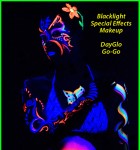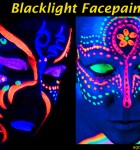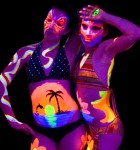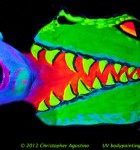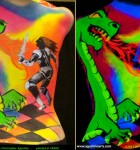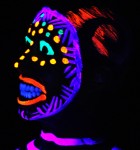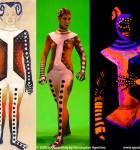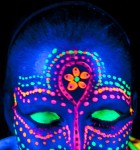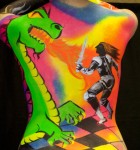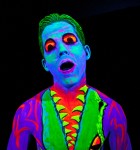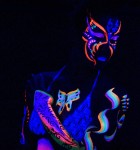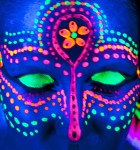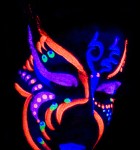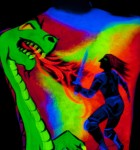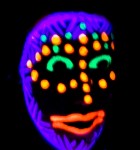Kumadori: the Makeup of Aragato Kabuki
see also: The Eye of the Demon — a StoryFaces Performance to learn about the stage presentation I do based on the legends of the samurai and the demons that they fight
by Christopher Agostino – published 1/20/12, occasionally revised since
“In a way completely different from the realism and individualism basic to the makeup used in Western theatre, Kumadori stylistically beautifies and emphasizes the stereotypical personality of a specific role. At the same time, unlike the Noh masks or the Chinese stage makeup used in Peking Opera, the Kumadori allows for greater power of expression since it closely follows the actual facial features and expressions of the actor.” — Toshiro Morita, Kumadori, 1985

Suji-kuma pattern of the Aragato Kabuki samurai
In theatre traditions of Asia such as the Chinese Opera, Kathakali theatre of India and Japanese Kabuki, the actor is the show. The stories are well known myths and historical epics, so everyone knows the plot. The audience is there to see the performer’s mastery of stylized movements, traditional vocal patterns and their otherworldly appearance in costume and makeup, as they embody legendary roles in a larger-than-life fashion.

The samurai character in action
The actors become living special effects to present the story, and extravagant masking and makeup is integral to this complete transformation of the actor, so Asian theatre generally includes the most sophisticated facepainting designs in the world, such as the Kumadori makeup tradition in Japanese Kabuki theater. The use of transformational makeup in Japan can be traced back to ancient religious rituals and, over time, as such ceremonies evolved into theatre, makeup was retained as a vehicle for transforming the actor in performances maintaining elements of the ritual origins without the specific religious context. Examples of this transition from religious ceremony to theatre can be found in many world cultures, often retaining elements of masking and makeup to allow modern performers to portray supernatural and mythological figures.

A living special effect
We can glimpse a direct link between the famous makeup for the samurai hero of the Aragato style of Kabuki and the ancient use of makeup in rituals pertaining to spirit worship and shamanic possession, for the samurai’s ability to do the impossible is understood to be because they have allowed themselves to be possessed by a powerful kami (“supernatural deity”) and thus have become hitokami (“man-gods”) and a functionality of any extravagant transformational makeup like this is to generate the suspension of disbelief in the audience so that they can accept the convention that they are in the presence of supernatural beings during the performance (just think of the way Hollywood movies use CGI today to make us believe we are on another planet watching blue aliens run through strange forests for the modern version of this age-old concept).  In the Edo region of Japan in 1673, a fourteen-year-old actor named Ichikawa-Danjuro I invented a Kabuki performance style called the Aragato, or the “wild show”, with stories centered around powerful samurai heroes to present the “super-human actions that a righteous and courageous hero undertakes in standing up to forces of evil (Toshiro Morita, Kumadori, 1985)”, and for his first performance he painted his face in a bold red and black makeup design—a modern example of which is at the top of the post, this suji-kuma or “sinew pattern” worn by the samurai hero of one of the Aragato dramas as it is seen today. (And, to be clear, real samurai did not paint their faces—this is an actor’s invention to project the inherent power of the character he portrayed) The complex stylized makeup in Aragato Kabuki is called “Kumadori”.
In the Edo region of Japan in 1673, a fourteen-year-old actor named Ichikawa-Danjuro I invented a Kabuki performance style called the Aragato, or the “wild show”, with stories centered around powerful samurai heroes to present the “super-human actions that a righteous and courageous hero undertakes in standing up to forces of evil (Toshiro Morita, Kumadori, 1985)”, and for his first performance he painted his face in a bold red and black makeup design—a modern example of which is at the top of the post, this suji-kuma or “sinew pattern” worn by the samurai hero of one of the Aragato dramas as it is seen today. (And, to be clear, real samurai did not paint their faces—this is an actor’s invention to project the inherent power of the character he portrayed) The complex stylized makeup in Aragato Kabuki is called “Kumadori”.

The “Demon Queller Glare” as depicted by printmaker Kuniyoshi
His makeup is so fierce that the actor can strike a “glaring pose” to scare away evil spirits—an ingenious element of the samurai pattern achieved by leaving the eyelids white while framing the eyes above and below with black lines so the actor can make maximum use of his eyes and they seem to grow impossibly wide as he stares. This “glaring pose” is the theatrical embodiment of samurai legend, that a true hitokami samurai could scare evil spirits away just by glaring at them, and this again points to the connection between theatre and ritual as it is said that Danjuro miraculously cured a man of his afflictions by glaring at him, proving that he too had a touch of the gods in him.
“Kabuki makeup is already in itself an interpretation of the actor’s own through the medium of the facial features. On stage this interpretation becomes a temporalization of makeup in collaboration with the audience. The result is a decoding of the drama traced out in the graphic designs of the painted face.” — Masao Yamaguchi (quoted in The Painted Body, 1984)

painting the suji-kuma: “taking the pattern”
The influences on the development of Kumadori may have included the mask traditions of Noh and other Japanese theatre styles, and also the painted faces of the Chinese and Peking Opera, however, there is a difference in the intention and theatrical effect. Theatrical masks, such as Noh masks, free the actor from naturalistic facial expression, so that all the elements of performance are within the structured movements of the body, and Chinese Opera designs, although they are painted onto the actor’s face, also function very much as physical masks obscuring the actors’ features and expressions. Kumadori makeup does not function as a mask to hide the actor. It is a makeup designed to capture and project the expressions of the actor in enhanced form, to externalize the inner persona of the role through a design that responds to the actor’s features.

the Evil Aristocrat
Toshiro Morita writes that Kumadori should not be described as painting an actor’s face but rather as a “pattern-taking”, as in taking an impression of his own face, and in the original tradition, Kumadori was applied by the actor with his fingers so he could take the pattern of his bone structure as he painted himself. Painted today with fingers and brushes, the Kumadori still lives and moves with each facial gesture, through designs bold enough to project the performance throughout the theatre. The concentrated process of painting himself is also part of the actor’s internal preparation to present the mythic persona required. The different traditional characters each have general makeup patterns they wear, with subtle variations to develop sub-types for specific characters, following a “Yin/Yang” color symbology system.  Aragato dramas are intense, and deal primarily with the expression of anger, of which there are two types in Yin/Yang symbology: the positive, extroverted “Yang” type (red) and the negative, introverted “Yin” type (indigo blue). So the red stripes radiating from the center of the samurai suji-kuma express the positive Yang anger of the hero, denoting his youthful vitality and therefor hot-bloodedness, coupled with a strong sense of righteousness as he acts openly and directly “with the heart of a child.” Other red patterns may be used for animals and comic roles. Indigo patterns represent the Yin anger more common to mature adults who have learned the conventions that govern society and so do not express their anger, but hold it in until it darkens the heart and turns one to evil, and those patterns are worn by characters such as evil aristocrats, vengeful spirits and demons. Browns in a pattern indicate a being has non-human powers, such as gods or demons. “The stage regained its original character as a sacred space, and the players their supernatural power…The significant thing is that makeup thus recovered its magical function as a vehicle of the supernatural, deliberately transgressing the natural features of the human face,” writes Michel Thévoz (The Painted Body, 1984) about the fascination engendered in Europe of the 1950s by presentations of Kabuki theatre. He’s talking particularly about the impact of the degree of transformation and stylization in traditional Japanese theatre in opposition to the naturalistic realism of the prevailing theatre in Europe and America, but if we are looking to the place that makeup has retained its “magical function” in modern Western culture we can more readily look to movies, even the cheesy sci-fi movies of those same 1950s. In my explorations of body art from tribal origins through modern cultures, I see an interesting evolution. In its original function, body art is a social act, elevating an individual above his natural/animal state to mark him as a member of human culture and his specific social group. In modern cultures, transformational makeup survives in the arts, in theatre, in movies, where its most profound use is to take the wearer (an actor) beyond his humanity so he can portray the supernatural and the super-human.
Aragato dramas are intense, and deal primarily with the expression of anger, of which there are two types in Yin/Yang symbology: the positive, extroverted “Yang” type (red) and the negative, introverted “Yin” type (indigo blue). So the red stripes radiating from the center of the samurai suji-kuma express the positive Yang anger of the hero, denoting his youthful vitality and therefor hot-bloodedness, coupled with a strong sense of righteousness as he acts openly and directly “with the heart of a child.” Other red patterns may be used for animals and comic roles. Indigo patterns represent the Yin anger more common to mature adults who have learned the conventions that govern society and so do not express their anger, but hold it in until it darkens the heart and turns one to evil, and those patterns are worn by characters such as evil aristocrats, vengeful spirits and demons. Browns in a pattern indicate a being has non-human powers, such as gods or demons. “The stage regained its original character as a sacred space, and the players their supernatural power…The significant thing is that makeup thus recovered its magical function as a vehicle of the supernatural, deliberately transgressing the natural features of the human face,” writes Michel Thévoz (The Painted Body, 1984) about the fascination engendered in Europe of the 1950s by presentations of Kabuki theatre. He’s talking particularly about the impact of the degree of transformation and stylization in traditional Japanese theatre in opposition to the naturalistic realism of the prevailing theatre in Europe and America, but if we are looking to the place that makeup has retained its “magical function” in modern Western culture we can more readily look to movies, even the cheesy sci-fi movies of those same 1950s. In my explorations of body art from tribal origins through modern cultures, I see an interesting evolution. In its original function, body art is a social act, elevating an individual above his natural/animal state to mark him as a member of human culture and his specific social group. In modern cultures, transformational makeup survives in the arts, in theatre, in movies, where its most profound use is to take the wearer (an actor) beyond his humanity so he can portray the supernatural and the super-human.

Exploring how Kumadori changes with my expressions as I painted this one on myself for my book

Sometimes I’ll use the eyes on the eyelids trick to create the “glare”.

Painting the suji-kuma in a demonstration for the Art Educators of New Jersey conference
There are a lot of lessons from such an effective and sophisticated art as Kumadori that I can apply as I paint a face. The foremost might be the importance of fitting a design to an individual’s features, “taking the pattern”. I am also perpetually intrigued by the idea of a painted face that does not mask the individual but rather projects the inner persona. I sometimes paint the suji-kuma face on an audience volunteer in my stage demonstrations on transformational makeup, both because it is such an exemplar of the power of makeup and because I’ve found that if I do take the time to paint it right and match the person’s features that the “glaring pose” always works, so I can show an audience just how theatrical makeup designs work to support an actor. As a vehicle for generating new facepainting designs I respond to the apparent looseness of the line work in these faces, the rough boldness. The sinuous lines make me think of movement, of wings and flying, so I have developed a number of bird designs out of the Kumadori patterns. I’ve also found these designs a great basis for some really fun spooky designs, see the Kabuki Spooky post. I’m a big fan of samurai movies—Toshiro Mifune in all those great Kurosawa films, like Yojimbo and The Hidden Fortress—so I enjoy keeping alive the samurai transformation tradition. As a final note, much of the information here was from a fantastic book that is one of the real treasures in my library: Kumadori, by Toshiro Morita. (go to the Books page for bibliography info) I received this book as a wedding present from an equally treasured friend. Thank you Kate!
“The metamorphosis of a Kabuki actor begins in his make-up. They call it ‘face making’ or ‘face preparation.’ Painting out their ordinary faces, they color in to create their new faces. The make-up is the basic condition for an actor’s metamorphosis and it is the first step to be taken in the process, a new beginning. From being a live in-the-flesh human, with every dab of paint, the actor inches closer to becoming one with the character of his given role. It is a process transcending the mundane dimensions of time and space.” — Toshiro Morita, Kumadori , 1985

I painted these “Kabuki Kids” in traditional Kumadori patterns in 2006 for my book

The traditional Kabuki Ghost design, and examples on people at events.

Taking the sinew pattern into “birds of prey” concepts

The “Monkey” pattern is not a monkey, but a comic servant

Benkei Pattern

Kuniyoshi print

“Kabuki Spooky” examples, turning the patterns into demon faces and vampires

Kabuki Spider

Trying out the red-faced version

The Noh Theatre mask exhibit at the American Museum of Natural History
See Talking Art for information about my stage presentations on the origins and history of masks and makeup arts. See agostinoarts.com to learn about all we do.
On Instagram at christopheragostino

 We use UV makeups to create special effects under backlight for parties and events, and to add dayglo “pop” to our face and body painting. Special effects paintings range from fully painted glowing models, 60s style Go-Go Dancers and specialty bodypainting for clubs and evening events.
We use UV makeups to create special effects under backlight for parties and events, and to add dayglo “pop” to our face and body painting. Special effects paintings range from fully painted glowing models, 60s style Go-Go Dancers and specialty bodypainting for clubs and evening events.

